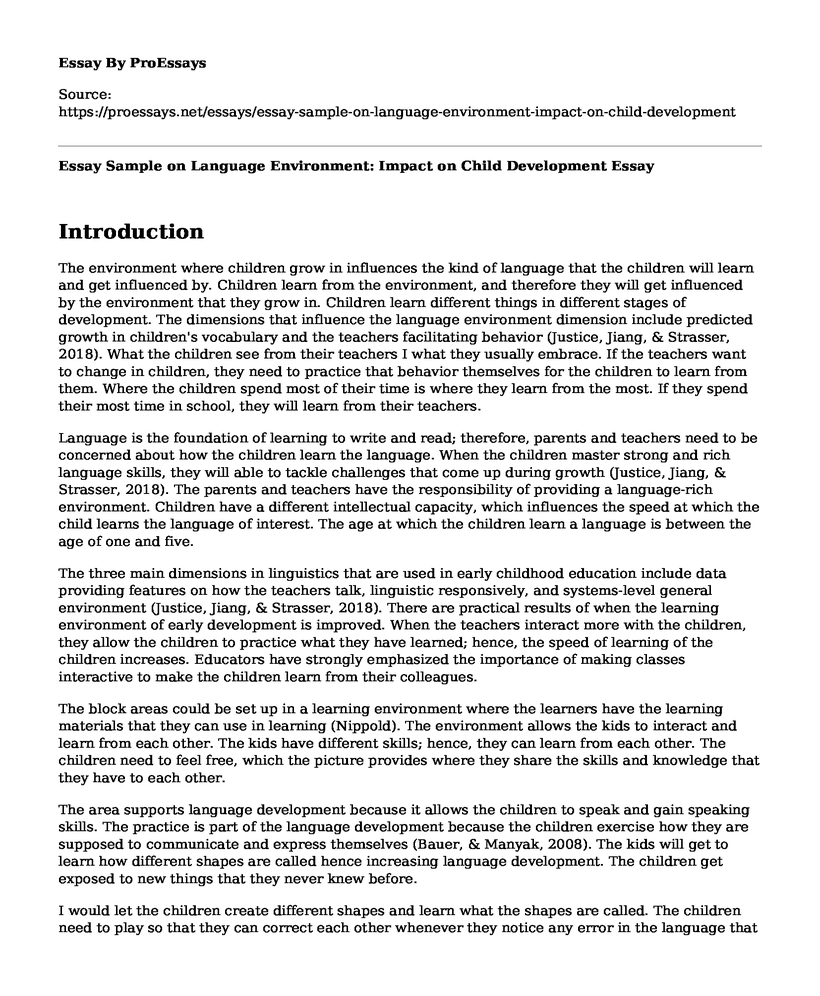Introduction
The environment where children grow in influences the kind of language that the children will learn and get influenced by. Children learn from the environment, and therefore they will get influenced by the environment that they grow in. Children learn different things in different stages of development. The dimensions that influence the language environment dimension include predicted growth in children's vocabulary and the teachers facilitating behavior (Justice, Jiang, & Strasser, 2018). What the children see from their teachers I what they usually embrace. If the teachers want to change in children, they need to practice that behavior themselves for the children to learn from them. Where the children spend most of their time is where they learn from the most. If they spend their most time in school, they will learn from their teachers.
Language is the foundation of learning to write and read; therefore, parents and teachers need to be concerned about how the children learn the language. When the children master strong and rich language skills, they will able to tackle challenges that come up during growth (Justice, Jiang, & Strasser, 2018). The parents and teachers have the responsibility of providing a language-rich environment. Children have a different intellectual capacity, which influences the speed at which the child learns the language of interest. The age at which the children learn a language is between the age of one and five.
The three main dimensions in linguistics that are used in early childhood education include data providing features on how the teachers talk, linguistic responsively, and systems-level general environment (Justice, Jiang, & Strasser, 2018). There are practical results of when the learning environment of early development is improved. When the teachers interact more with the children, they allow the children to practice what they have learned; hence, the speed of learning of the children increases. Educators have strongly emphasized the importance of making classes interactive to make the children learn from their colleagues.
The block areas could be set up in a learning environment where the learners have the learning materials that they can use in learning (Nippold). The environment allows the kids to interact and learn from each other. The kids have different skills; hence, they can learn from each other. The children need to feel free, which the picture provides where they share the skills and knowledge that they have to each other.
The area supports language development because it allows the children to speak and gain speaking skills. The practice is part of the language development because the children exercise how they are supposed to communicate and express themselves (Bauer, & Manyak, 2008). The kids will get to learn how different shapes are called hence increasing language development. The children get exposed to new things that they never knew before.
I would let the children create different shapes and learn what the shapes are called. The children need to play so that they can correct each other whenever they notice any error in the language that they speak. I will assess the effectiveness of the areas based on whether the children learned new things that they did not know before or not.
The area on the picture could be the set up for learning where the learners are allowed to practice the language skills through reading (Nippold). The exposure to reading materials exposes the learners to an environment of learning the art reading the language that one is learning. The area supports language development because the learners get new vocabulary from the stories that they read. Books are rich in vocabulary; hence, the children will learn new words.
There are different books for different ages; therefore, I would allocate books depending on the age of the child. Young children would be given materials to different color shapes; then, I ask the children to name the shapes. I would measure the effectiveness by asking the children to name the items that they colored. The language would occur as the children learn new words.
The set up on the image can provide a learning environment where the children and the teacher talk and exchange ideas on the issues that they have learned in class (Nippold). The teacher gets the opportunity to get feedback from the learners, whether they are improving their language skills. The area supports language development because the learners get the opportunity to be corrected the errors that they may have.
The teachers get the opportunity to decide what the learners practice as they learn the language. The environment allows the children to learn from their teacher on the errors that they might be making. The effectiveness of the area can be measured by the teacher from the feedback that they get from the children when they ask them questions.
References
Bauer, E. B., & Manyak, P. C. (2008). Creating language-rich Instruction for EnglishLanguage Learners. The Reading Teacher, 62(2), 176-178.
Justice, L. M., Jiang, H., & Strasser, K. (2018). The linguistic environment of preschool classrooms: What dimensions support children's language growth?. Early Childhood Research Quarterly, 42, 79-92.
Nippold, Marilyn A. Later language development: School-age children, adolescents, and young adults. PRO-ED, Inc. 8700 Shoal Creek Boulevard, Austin, TX 78757-6897, 2016.
Cite this page
Essay Sample on Language Environment: Impact on Child Development. (2023, Mar 13). Retrieved from https://proessays.net/essays/essay-sample-on-language-environment-impact-on-child-development
If you are the original author of this essay and no longer wish to have it published on the ProEssays website, please click below to request its removal:
- Alpha Level: Education Paper Example
- Lives of LGBTQ Students Annotated Bibliography
- School Safety: Why Are School Seeing Problems With Safety? - Essay Sample
- Essay on Adolescent Cognitive and Emotional Development: A Playful Approach
- Essay Example on Unlock Literacy Skills With English Literature: A Must for Schools
- Paper Example on My Journey as a Queer Black First-Gen Student: Overcoming P-20 Challenges
- Big-Time Sports: College Sponsorship & Education Benefits - Paper Example







